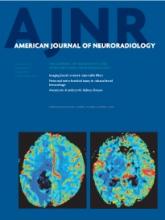Intracranial aneurysm (ICAN) formation is a well-known complication in patients with autosomal dominant polycystic kidney disease (ADPKD). In these patients, aneurysms are thought to form as a consequence of abnormal polycystin protein expression in vascular myocytes, which impairs the structural integrity of vessel walls.1⇓⇓–4 ICAN rupture with SAH is the most serious morbidity associated with ADPKD.
ICANs, both in ADPKD and the general population, are acquired abnormalities that are thought to form during a relatively short time. A defect in the elastic lamina of a vessel permits outward bulging, the extent of which is determined by the opposing forces of arterial blood pressure and residual elasticity of the vessel. A new aneurysm will either rupture or stabilize due to collagenous scarring. Aneurysms smaller than approximately 7 mm are less likely to rupture initially and may be less likely to expand with time. Because ICAN formation in ADPKD is associated with a defective vessel wall protein, the time course and dynamics of aneurysm stabilization and growth could potentially be altered. Most interesting, ICAN formation in ADPKD is not dependent on the presence of arterial hypertension,5,6 though ICAN rupture is.
The value of widespread radiographic screening for ICANs in asymptomatic patients with ADPKD is controversial, mainly because of the potential risk involved in pre-emptively treating incidentally detected aneurysms. Knowing which patients are more likely to have aneurysmal SAH could help stratify high-risk patients toward endovascular or surgical aneurysm repair and low-risk patients toward counseling and periodic imaging surveillance.7 One limitation of screening is that aneurysms that rupture around the time of their formation could be missed by infrequent imaging.
Regarding screening of asymptomatic patients, 3D time-of-flight MR angiography is the technique of choice because it avoids the risk assumed with contrast-based angiography, including iodinated contrast-induced nephropathy8 and gadolinium contrast-induced nephrogenic systemic fibrosis,9 as well as complications related to catheter-based angiography.10 For acutely symptomatic patients, urgent CT or catheter-based angiography should be performed.
Although the prevalence of ICANs in ADPKD increases with age, small studies have not demonstrated an increased rate of aneurysm growth and rupture compared with age-matched non-ADPKD populations.11,12 The risk of aneurysm rupture in ADPKD is linked to a family history of ICAN and prior SAH.5,6,13 In a retrospective study of 369 patients with ADPKD, the mean age of aneurysmal SAH in ADPKD was found to be slightly less than that in the general population (53 compared with 57 years of age).5 Additional risk factors for aneurysm rupture are extrapolated from the International Study of Unruptured Intracranial Aneurysms (ISUIA)14 and include aneurysm features such as size, shape, and location, as well as the presence of neurologic symptoms or signs. Now, patients with ADPKD with a family history of ICAN or prior SAH are routinely screened.
For patients with ADPKD without a family history of ICAN or prior SAH, the benefit of screening is less clear, and there are small clinical studies and meta-analyses advocating for6,15 and against11,12 routine screening. In the largest of these studies, which examined a cohort of 355 patients in China,6 the prevalence of ICAN increased with age, from 6.0% in the 30- to 39-year age group to 23.3% in the 60- to 69-year age group. On the basis of these findings, the authors favored screening all patients with ADPKD 30 years of age or older.
Niemczyk et al16 examined the prevalence of ICAN in ADPKD in a population of 83 adult patients in Poland. The data presented in this patient group were roughly concordant with those in other studies in terms of overall ICAN prevalence in ADPKD and increased ICAN prevalence with age. No risk factors were identified to predict ICAN rupture in younger patients. As in the study by Xu et al,6 the authors recommended screening all patients older than 45 years of age.
A recommendation to preferentially screen older patients with ADPKD should be balanced by safety analyses of potential endovascular or surgical interventions. Elevated morbidity and mortality rates in patients older than 50 years of age undergoing craniotomy and surgical clipping and older than 70 years of age undergoing endovascular coiling have been reported.17 Older patients with ADPKD commonly develop renal failure as well as arterial hypertension and may have even greater postoperative complications compared with younger patients with ADPKD or age-matched patients without ADPKD.
The economics of screening has been studied as well. A decision analysis of aneurysm screening versus nonscreening in ADPKD15 showed the greatest benefit in younger patients, in whom identification and treatment of an asymptomatic aneurysm increased life expectancy. As stated above, however, ICAN rupture in young patients is considerably rarer than in older patients. A risk analysis of treatment versus nontreatment based on ISUIA data18 did not favor clipping of unruptured aneurysms of <10 mm, though analyses of potential life-years saved in subgroups including ADPKD could not be calculated because the natural history and treatment risks in these subgroups are unknown.
The principles of a screening test, as originally described by the World Health Organization, include an understanding of the natural history of the disease in question as well as consensus on whom to treat.19 Whether the natural history of aneurysm formation, growth, and rupture risk in ADPKD parallels that of the general population remains unsettled. More data are needed from the ADPKD population to generate evidence-based guidelines for radiographic screening.
REFERENCES
- © 2013 by American Journal of Neuroradiology











